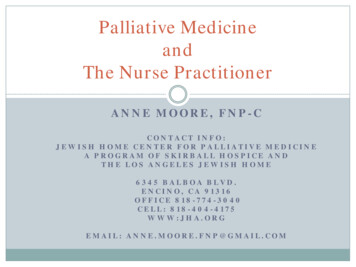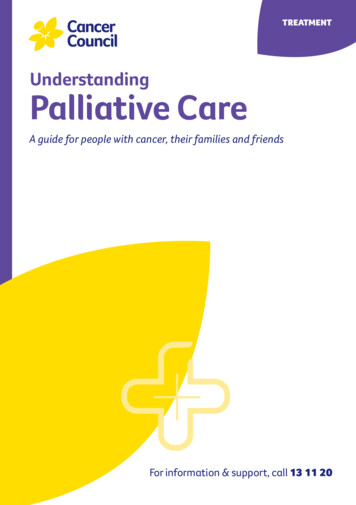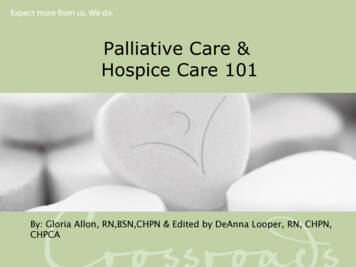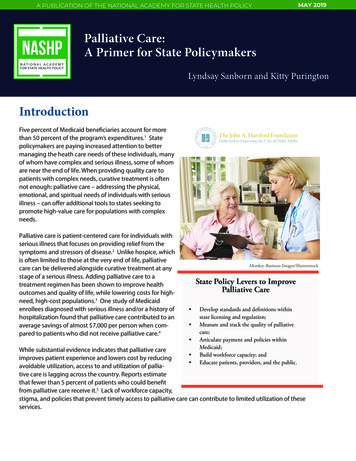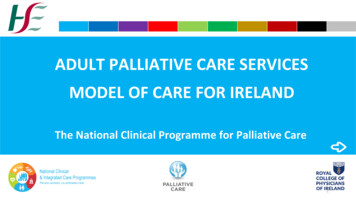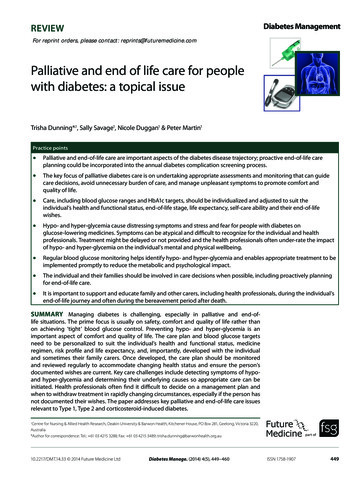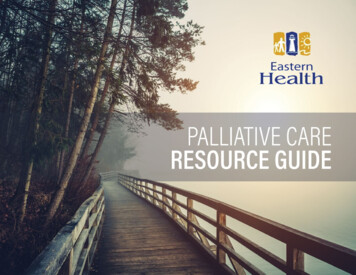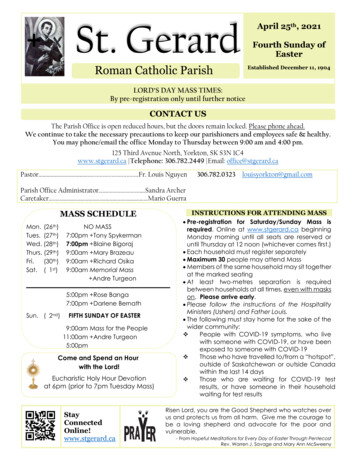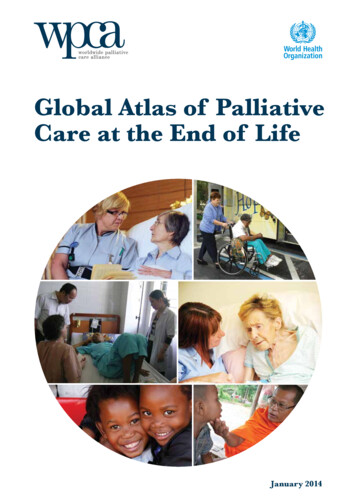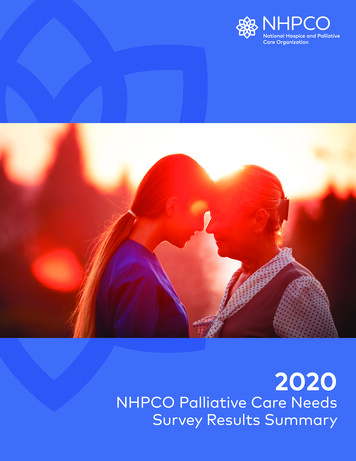
Transcription
2020NHPCO Palliative Care NeedsSurvey Results Summary
SummaryThe NCP Clinical Practice Guidelines for Quality PalliativeCare (Fourth Edition), provide structure to ensure qualitypalliative care services. Accrediting organizations utilize theNCP Guidelines as their foundation for palliative careaccreditation. The Palliative Care Needs Survey offers anopportunity to expand awareness and educate on the valueof the NCP Guidelines. While most providers are utilizingthe NCP Guidelines, 19 percent are unsure, not familiar, ornot following them at all (this is an improvement from 32percent in the 2018 survey the survey).Palliative care services have grown rapidly in the hospitalsetting. As the seriously ill population grows exponentially,so does the need for community-based palliative careservices. Hospice providers are ideally positioned to meetthis need, and many are already engaged in providingpalliative care services. While the focus of care is markedlydifferent, the model of palliative care mirrors the hospicemodel: holistic care provided to the patient andfamily by an interdisciplinary team supporting69 percent (was 53symptom and medication management, goalspercent in 2018) areof care discussions, advance care planning, andproviding palliativecare coordination.Palliative care programs leverage aninterdisciplinary team to provide services withthe bulk of team members directly employed bycare services while an the organization. Most programs have three orNHPCO distributed the 2020 Palliative Careadditional 24 percent more disciplines on their palliative care team.Needs Survey to our members beginning in(was 35 percent in The most common core team members areJune. We extended the deadline numerous2018) are considering nurse practitioner, physician, and registeredtimes due to the ongoing pandemic. We alsonurse, followed by chaplain and clinical socialor in the process ofopened the access to participate beyondworker. The percentage of staff certified hasdeveloping theseNHPCO members. The final deadline toincreased in all core discipline categories exceptservices.complete the survey was September 30, 2020.for physicians. Physicians still have the highestOut of the respondents, 69 percent (was 53percent of palliative care certification (64.5%),percent in 2018) are providing palliative care serviceswhile 45 percent of nurse practitioners and 42.5 percent ofwhile an additional 24 percent (was 35 percent in 2018)registered nurses are certified. Other certified disciplinesare considering or in the process of developing theseinclude social workers (39.6%), chaplains (11%), and aidesservices. Respondents represent palliative care services in(12%). We provide an average caseload per discipline this47 states. This report summarizes the results for all whoyear (see table on page 7).answered the question “Do you provide formal palliativeA variety of palliative care services are provided by thesecare services ”. The results include the services theseprograms. The highest identified services are symptomprograms are providing, the challenges they aremanagement (175), patient/family education (174), goals ofexperiencing, and the opportunities for NHPCO to supportcare discussions (173), advance care planning (172),development and sustainability of palliative care servicescomprehensive assessment (170), care coordination (164),provided by hospice agencies. You will find the full surveyPOST/POLST completion (150), and medicationresult details directly after this summary report.management (149). Other notable services provided byMost respondents providing palliative care services havesome include spiritual care (108), individual counseling (89)mature community-based palliative care programs andand family counseling (89).over 89,609 seriously ill individuals were servedReimbursement is essential to the sustainabilityin 2019 (compared to 85,153 in 2017). While theOver 89,609of palliative care services. Medicare B fee-forprimary location of services provided isseriously illservice billing is the most common reimbursementcommunity-based (home, assisted living facility,individuals were source (136). However, most programs utilize twoand long-term care), most of these organizationsserved in 2019or more types of reimbursement. Additionalare providing care in multiple settings, including(comparedtoreimbursement categories include contracts withthe hospital and clinic. Over 72 percent of thesepayers (81), private pay (49), hospital or other85,153in2017).respondents have served palliative care patientspartnership model (27), philanthropy (26), subsidyfor three or more years. New this year, we askedby parent corporation (22), grants (22), Medicare homeabout the provision of telehealth services. Over 90 percenthealth (21), and arrangements with an Accountable Careof respondents are providing telehealth services andOrganization or Medicare Shared Savings Plan (15).settings where telehealth is offered mirror the settingswhere palliative care services are provided.NHPCO / 2020 Palliative Care Needs Survey Results Summary2
Use of an electronic medical record can improveobtaining appropriate and adequate volume of referralscommunication to healthcare partners and simplifies data(114). Revenue management is the second greatestcollection for quality reporting and billing. Over 85 percentchallenge: contracting with payers (139), Medicare B billingof respondents utilize an electronic medicaland coding (137), and collaborating/contractingOver 85 percent of with ACOs and MSSPs (103). Human resourcerecord (decreased from 90 percent in 2018).respondents utilize management was identified as the thirdOne of the challenges for community-basedorganizations are the variety of electronicgreatest challenge: recruitment and retentionan electronicmedical record vendors (38) and the lack of(68), productivity (67), and training andmedical record.government incentives to mandatecertification (52). Organization support andinteroperability in the community-based care setting. Somebuy-in ranked 4th: buy-in from field staff in other programsparticipants use more than one EMR solution. The top five(64), buy-in from other providers in the organization (61),vendors identified are NetSmart (26), Epic (20),and buy-in from the C-suite (19). Other challengesHomeCareHomeBase (13), Cerner (11), MatrixCare/identified were measurement/metrics to demonstrateBrightree (9).value (93) and documentation (53).Leveraging data to manage the patient population andParticipants were asked about preferences in how NHPCOdemonstrate program outcomes is essential ascan assist them in development and sustainability ofreimbursement shifts from traditional fee-for-service topalliative care services. The top area for assistance wasvalue-based. Approximately 77 percent of respondentsengaging and contracting with payers (159); followed bycollect data for metrics. However, 34 percent dodata collection, analysis, metrics, and77 percent ofnot participate in any public reporting or databenchmarking (142). Other top areas of needsharing (a decrease from 57 percent in 2018). Of respondents collect include sample documents (139); advocacy atthose that do, 31 percent participate in thethe Federal level (132) and the state level (130);data for metrics.CAPC Data Registry; 9.5 percent participate inreferring provider outreach and marketing (130);the new Palliative Care Quality Collaborative; 8 percentstaff training and competencies (127); patient educationparticipate in the Palliative Care Quality Network (PCQN);resources (127); and metrics and measurement resourcesand 2 percent participate in the Global Health Partners(126).QDACT. Types of metrics tracked include operational (117),The overwhelming preference for education assistance isutilization (83), patient experience/satisfaction (83), clinicalthrough webinars (198), followed by conferences (95),(73), process (73), and financial metrics (64).telephone consultation (40), and site visit (19).State palliative care legislative activity is important toWe included a question about current NHPCO resourcesincrease awareness, access, and program sustainability. Asthat participants found helpful. CMS information onleaders in the provision of community-based palliative carepalliative care topped the list (114), closely followed by theservices, hospice agencies should engage in these activities.NHPCO Palliative Care Playbook (107). Other helpfulMost programs (108) are active in their state association;resources include the palliative care webinar series (97), andhowever, a large number (105) do not participate in statepalliative care education and links (89). The Palliative Carepalliative care activities. Of those that do participate inPlaybook was created based on the results from the 2018state activities: 53 are active in their state palliative carePalliative Care Needs Survey.coalition; 42 participate in Medicaid policy/reimbursementactivity; and 27 are active in regulation/licensure revision.The 2020 survey included an additional set of questions onNote: The largest number of respondents was from thebehavioral health and palliative care. A subset ofstate of California (49) where SB 1004 required a palliativerespondents (46) participated in these additional questions.care benefit for all MediCal beneficiaries by January of 2018When asked about existing behavioral health resources,and SB 294 allows hospices to participate in the provisionsocial workers were identified as the top resource (39),of palliative services to MediCal beneficiaries. (The numberfollowed by pastoral services (31) and links to communityof 2018 survey participants from CA was 26).and social services (19). Most prefer providing structuralThe greatest challenge and barrier identified byrespondents is referral management: referring providersnot understanding of palliative care (147), a lack ofpatients/families understanding of palliative care (129) andNHPCO / 2020 Palliative Care Needs Survey Results Summaryand clinical behavioral health features within their palliativecare team (25); second was available when necessary (22);access to psychiatrist and psychologist tied for third (20).Funding opportunities (33) to pay for integrated behavioral3
was identified as most helpful; providing staff training curriculum (31); and logistical help (19). The top behavioral healthcategories supported by palliative care programs currently are anxiety, cognitive impairment, depression, existential/spiritualissues, and grief/bereavement.The survey results provide important information that demonstrates hospice providers are expanding their services to meetthe needs of seriously ill individuals and their families, particularly in the community setting. NHPCO and the NHPCO PalliativeCare Council are committed to developing (or partnering to provide) tools, resources, and education to support our membersin the provision of palliative care services.Palliative Care Needs 2020 Survey ResultsThe survey was open to NHPCO members from June 15 to September 30. The survey opened to non-members fromJuly 1 through September 30.Total Surveys Mailed: 2200Responses 328includes all who answered “Do you provide formal palliative care services ”Response rate: 15%There was a total of 23 responses that answered no further questions after responding to whether or not they provideformal palliative care services. There were 8 that responded Yes, they do provide formal palliative care services but did notfill survey out further.This report summarizes the results for all who answered the question “Do you provide formal palliative care services -45-910-13FL14-1920-2645-49HINHPCO / 2020 Palliative Care Needs Survey Results Summary4
Do you provide formal palliative careservices separate and distinct fromhospice services?In what settings do you providepalliative care?YesAssisted living facility225Patient’s homeLong term care facilityConsidering or in the process of developing77HospitalNo and no plans to develop palliative care services22OtherPercent of Respondents ProvidingPalliative Care Services69%201814887Clinic5118How many years have you been servingpatients in your palliative care program? 1 year2020192158231-2 years343-5 years60 5 years53%Are you part of a multi-siteorganization?88Number of Patients Served202089,609Yes201813585,153No196To which age groups do you providepalliative care services?Adults Only159Adults and Pediatrics61PediatricsDo you follow the National ConsensusProject (NCP) Clinical PracticeGuidelines for Quality Palliative Care(4th edition)?Completley33Mostly85Partially540Do you have a specialized pediatricprogram (dedicated staff with pediatricexpertise)?Not at All5Unsure / I am not familiar with the NCP Guidelines33Yes35No26NHPCO / 2020 Palliative Care Needs Survey Results Summary5
Please select the members that are on your team.Nurse Practitioner175Physician169Registered Nurse127Chaplain102Clinical Social Worker90Social Worker85Practical Nurse45Health Aide or CNA41Other28Pharmacist19Therapy Services16Dietician14Physician Assistant13Community Health Worker 8Number and percent of interdisciplinary team members that are certifiedPhysician(Certified) 10964.5%(Total) 169Nurse Practitioner(Certified) 7945%(Total) 175Physician Assistant(Certified) 1 8%(Total) 13Registered Nurse(Certified) 5442.5%(Total) 127Licensed Practical Nurse(Certified) 24%(Total) 45Licensed Social Worker(Certified) 2426.6%(Total) 90Social Worker(Certified) 1113%(Total) 85Chaplain(Certified) 1111%(Total) 102Health Aide/CNA(Certified) 512%(Total) 41NHPCO / 2020 Palliative Care Needs Survey Results Summary6
Average Caseload per Full Time EquivalentPhysician75.5Nurse Practitioner65Registered Nurse49Licensed Practical Nurse59Licensed Clinical Social Worker52.5Social Worker61Chaplain72.5Health Aide/CNA16Physician Assistant*35Pharmacist*49Community Health Worker*47* Less than 10 total reportedWhat type of services do you provide as part of your palliative care program?Symptom Management175Patient/Family Education174Goals of Care Discussion173Advance Care Planning172Comprehensive AssessmentCare Coordination170POST/POLST Completion164150Medication Management 149Spiritual Care 108Individual Counseling89Family Counseling89Bereavement66Volunteers 44Skilled Nursing CarePersonal Care3934Respite13Other (Please Explain)13Homemaker Services 6Do you offer telehealth?Yes188No20NHPCO / 2020 Palliative Care Needs Survey Results Summary90% Offer Telehealth7
In which settings do you offer telehealth?Patient’s Home172Assisted Living Facility137Long Term Care Facility118Hospital37Clinic27Other8How are you reimbursed for palliative care?Fee-for-Service Billing (Medicare B)136Contracts with Payers81Private Pay49Hospital or Other Partnership Model27Philanthropy26Grant22Parent Corporation Subsidies22Medicare Home Health Care Benefit21Arrangement with Accountable Care Organizations (ACO) or Medicare Shared Saving Plan (MSSP)15Do you use electronic documentation for palliative care?Yes152No26NHPCO / 2020 Palliative Care Needs Survey Results Summary85% use electronic documentation8
What is the vendor you utilize forelectronic documentation?What types of metrics do you use toevaluate your program?Operational Metrics (Such as average length of time patients are followed by service)136Clinical Metrics (Such as impact on pain scores)81Utilization Metrics (Such frequency of hospitalizations among enrolled patients)49Financial Metrics (Such as cost of care after program enrollment)22Process Metrics (Such as proportion of patients that receive acomprehensive assessment)21Patient Experience & Satisfaction Measures15Do you participate in the followingactivities to advance palliative care atthe state level?Do you collect data for measurementand reporting?State Association108Yes137Do Not Participate105NoState Coalition2653UnsureMedicaid Policy/Reimbursement421577% collect data for measurement and reportingRegulation & Licensure Rrevision27Do you participate in any of the belowlisted PC data registries?Do Not Participate60What are your greatest challenges orbarriers in providing palliative careservices?ReferralsCAPC Data Registry38655Palliative Care Quality Collaborative anization Buy In144Measurement/Demonstrating Value93Documentation53NHPCO / 2020 Palliative Care Needs Survey Results Summary9
Referral ChallengesReferring Provider Understanding147How can we assist you in developing andsustaining your palliative care services(topic areas)?Consumers/Patients Understanding PC125Contracts with payersObtaining Adequate Volume of Referrals114Data collection, analysis, metrics, benchmarking142159Sample documents139Reimbursement ChallengesFederal level advocacyReimbursement-Contracting with Payers139Reimbursement-Medicare B137Reimbursement-Contracting ACOs103132State level advocacy130Patient education127Staff training and competencies127Staffing ChallengesMetrics and measurement resources126Staff Recruitment and Retention68Staff Productivity67Documentation templates122Patient satisfaction79Staff Certification52How can we assist you in developing andsustaining your palliative care services(methods)?Organization ChallengesOrganization Buy In / Field Staff64Organization Buy In / Medical Staff61Organization Buy In / C-Suite19Webinars198Conferences95Consultation via phone40Consultation via site visit19NHPCO / 2020 Palliative Care Needs Survey Results Summary10
NHPCO palliative care resources that youhave found helpful?CMS Information on Palliative Care114Palliative Care Playbook107Palliative Care Webinar SeriesWhat structural and clinical featuresrelated to behavioral health care wouldyou want in your program that youcurrently do not have?Provided within the palliative care team25Available when necessary9722Palliative Care Education and LinksPsychiatrist(s)8920Palliative Care Resources SeriesPsychologist(s)6420Helpful Resources LinksSocial worker(s)6019Palliative Care Certification and Accrediation Information51Scheduled meetingsPalliative Care Needs Survey Report50Embedded BH specialistPediatric Palliative and Hospice Resources21Psychiatric nurse(s)121212MACRA Information and Link13By outside service(s)10Does your program have any of thefollowing features to support behavioralhealth care?Social Worker37Pastoral services31Established linkages to community and/or social services19Established linkages to behavioral healthproviders for referral14Quality improvement processes focused on BH5Other behavioral health/support personnel4Health information technology/ other support technologyrelated to BH4Psychiatrist2Psychologist1Psychiatric nurse0Funding/ reimbursement mechanisms0NHPCO / 2020 Palliative Care Needs Survey Results SummaryPastoral services10Other behavioral health/support personnel10What structural and clinical featuresrelated to behavioral health care wouldyou want in your program that youcurrently do not have?Funding opportunities33Staff training curriculum31Logistical help1911
Clinical Categories: Please provide anoverview of the services and processes inplace at your palliative care program/organizationFormal relationship with an external organization orproviders to treat individuals with these conditionson referral?Serious mental illnesses11Clinical guidelines/ documents to support clinicaldecision making for any of the following conditions?Substance use avement20Cognitive impairment (e.g., dementia, delirium)19Existential/ spiritual issues109Anxiety8Trauma-related conditions7Other psychosocial issues7Grief/bereavement186Substance use disordersExistential/ spiritual issues125Trauma-related conditionsCognitive impairment (e.g., dementia, delirium)114Other psychosocial issues11Serious mental illnesses7Specific staff training to address any of thefollowing conditions?Existential/ spiritual issues20Cognitive impairment (e.g., dementia, delirium)19Grief/bereavement19Anxiety16Substance use disorders15Trauma-related conditions15Depression14Other psychosocial issues11Serious mental illnesses9NHPCO / 2020 Palliative Care Needs Survey Results Summary12
W W W. N H P CO.O R G
Care Council are committed to developing (or partnering to provide) tools, resources, and education to support our members in the provision of palliative care services. Palliative Care Needs 2020 Survey Results The survey was open to NHPCO members from June 15 to September 30. The survey opened to non-members from July 1 through September 30.
